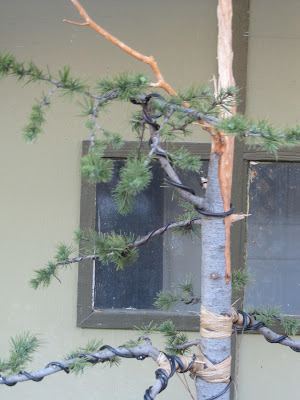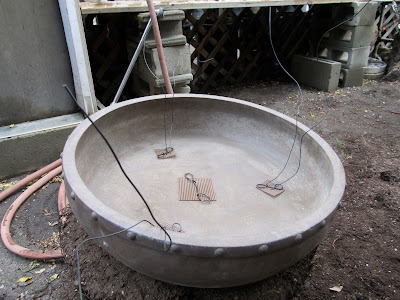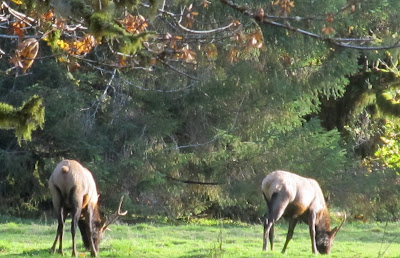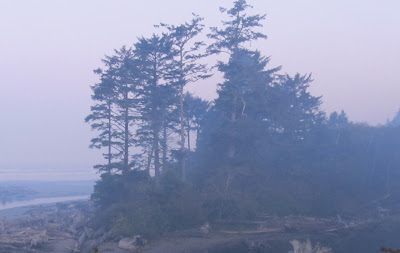Recently my wife and I made a trip to the Olympic Peninsula in Washington and we were awed by the majesty of the place. ( See here for the story http://bonsaibpsbonsaiblog-bonsai.blogspot.com/2011_11_06_archive.html )
I was inspired to recreate some of what I saw in bonsai so to that end I went searching through the nursery. Here is what I found- it's a 16' tall Atlas Cedar in a 24" tub.
First I had to cut the top off so we could bring it through the nursery without hitting the shade cloth or the ceiling of the breezeway.
What I want to create is a tree that invokes the feeling of strength and perseverance like one gets when seeing a tree high up in the tree line battered by everything mother nature can throw at it. It may have been struck by lightening, had most of its branches broken under the weight of countless winter snow storms, maybe even hit by a rockslide but still it grows on.
Many trees high up on the mountain have slim ,fairly straight trunks with minimal foliage due to the adverse growing conditions. For me they are some of the most impressive trees because they have survived for sometimes centuries in some of the harshest condition to grow in.
To start I decided that I wanted the top to be a jin- maybe like a tree struck by lightening or one the had the top snapped off in a windstorm. To do this I removed most of the upper branches and peeled the bark from the trunk and the two remaining top branches. I did this by using a branch splitter to split the trunk in several places and then used pliers to twist and tear the pieces off which left a twisted natural looking jin on the top.
To determine what the front was going to be I had to check the nebari or base of the tree.
There were a lot of old crossing roots that I removed. It was also planted deeper than it needed to be and once I got it all cleaned up I was pleasantly surprised to find a decent base on the tree.
Once I had the front determined it was time to figure out the rest of the tree.
Since these trees grow under such extreme conditions they don't usually have a lot of foliage mass. I knew I wanted a tree with a minimal amount of foliage so I started pruning-alot. I probably took off 80% of the original foliage.
After pruning I had to wire all the branches into the positions I wanted them. To do this I used various gauges of aluminum wire, some raffia to protect the branches and a few guy wires.
Now its time to reduce the rootball. I was planning on at least two transplantings to get it small enough to put in an appropriate pot. The root ball was so big and so packed with roots I needed power tools to do the initial reduction. This is a 24' high by 24' round solid mass of roots.
Much to my surprise I found the rootball to be filled from top to bottom with really fine roots. So many that I was able to safely do a much bigger reduction than I originally thought I could.
I had to trim a few bigger roots on the bottom but was amazed at the number and health of feeder roots throughout the root mass.
This presented a little bit of a dilemma as I was planning on putting it into a training pot not a bonsai pot. So After a search through our pot inventory I found this handmade Chinese drum pot that I thought would be appropriate.
So just a little more trimming around the edge of the roots and it fit just as if I had planned it.
Here is the finished tree. I will let the existing branches get fuller but I won't allow any additional branches to grow. I really want this tree to make a statement and once it fills out a bit I'm pretty sure it will.It's definitely taller than most bonsai at 55" but I think this tree will be able to pull that off.
In the future I may plant the tree in a stone similar to this to really enhance the idea that it's growing in the mountains.
Well that's it for todays subject. I hope you enjoyed it. I welcome any comments or suggestions.
A blog by Bob Pressler owner of Kimura Bonsai Nursery in Northridge, CA focusing on bonsai and various bonsai techniques, featuring many step by step photo essays.
Photos can be clicked on for a larger view.
Monday, November 28, 2011
Sunday, November 20, 2011
California Juniper refinements
Today I want to post a little about several California Junipers I've worked on in the last week or so.
The first one is a tree that was collected in Palmdale, CA in 1992 and was the first tree styled in a U.S. demo by Japanese bonsai master Kenji Miyata ,in I believe 1998. I acquired the tree the following year after it had been won in a raffle by someone who knew they didn't know what to do and were afraid they were killing it.
It was in pretty bad shape from being overwatered and in too much shade but a repotting and a few years of good care brought it back to health. Unfortunately I didn't take pictures through the years like I try to now, so only a couple of images of this tree. This is a very special tree- it's probably close to 1000 years old and in a multi-trunk style not often seen in California Junipers. It presents a powerful image of an old weather beaten but growing strong tree. I'll let the foliage get somewhat fuller than it is now but not too much. I don't feel that trees with this much deadwood look natural with thick lush foliage masses.
Before trimming and wiring-
After trimming and wiring almost every single branch and twig-
I hoping with some strong fertilizing and staying up on the pinching and thinning this one will be ready to show in 1-2 years.
This next one was one of the easiest California Junipers I ever collected. In February of 2003 a road crew in Lancaster, CA had just bulldozed a small stand of junipers. I stopped and grabbed one before they chased me off.
This tree has always made me think of two dancers. Its young for a California Juniper -maybe 250 years or so but it has plenty of character, both in the deadwood and the movement of the trunks. It's always seemed a little heavy to me so in this stage of the work I concentrated on reducing some of the bulk and refining the image. For the next step I'll probably do a little carving to accentuate the double trunks and finnish cleaning and treating the deadwood.
Here it is before the work-
This one is after the main trunk is wired. I'm using the towels to cover up branches I'm thinking about removing, so I can see what it'll be like if they were gone. It pays to be sure- once you cut it off there's no gluing it back. (Note - the deadwood looks so tan because I'm scrubbing off a buildup of lime sulphur that was starting to fill the pores of the wood.)
After deciding that those branches would go.
After the trimming and wiring. I still need to move the apex of the main trunk forward and do a little carving on the trunk. Look for this one to be show ready in 2013.
This last one is one of my favorite trees of its size. Its got all the character of a much larger tree- great deadwood, powerful trunk, good branching and a convincing image of an ancient tree -in a tree only 24" tall. Many California junipers with these characteristics are almost twice that size. I collected this tree in Kern County, CA in 2003 and did the initial styling in 2006. After this work it ready for transplanting into a better slightly shallower, darker rectangular pot.
Before the work-
After trimming and wiring every branch-
I hope you all enjoyed seeing these trees today. I'm always interested in your comments or ideas for future posts. Wishing everyone in the US a Happy Thanksgiving. Until next time.
The first one is a tree that was collected in Palmdale, CA in 1992 and was the first tree styled in a U.S. demo by Japanese bonsai master Kenji Miyata ,in I believe 1998. I acquired the tree the following year after it had been won in a raffle by someone who knew they didn't know what to do and were afraid they were killing it.
It was in pretty bad shape from being overwatered and in too much shade but a repotting and a few years of good care brought it back to health. Unfortunately I didn't take pictures through the years like I try to now, so only a couple of images of this tree. This is a very special tree- it's probably close to 1000 years old and in a multi-trunk style not often seen in California Junipers. It presents a powerful image of an old weather beaten but growing strong tree. I'll let the foliage get somewhat fuller than it is now but not too much. I don't feel that trees with this much deadwood look natural with thick lush foliage masses.
Before trimming and wiring-
After trimming and wiring almost every single branch and twig-
I hoping with some strong fertilizing and staying up on the pinching and thinning this one will be ready to show in 1-2 years.
This next one was one of the easiest California Junipers I ever collected. In February of 2003 a road crew in Lancaster, CA had just bulldozed a small stand of junipers. I stopped and grabbed one before they chased me off.
This tree has always made me think of two dancers. Its young for a California Juniper -maybe 250 years or so but it has plenty of character, both in the deadwood and the movement of the trunks. It's always seemed a little heavy to me so in this stage of the work I concentrated on reducing some of the bulk and refining the image. For the next step I'll probably do a little carving to accentuate the double trunks and finnish cleaning and treating the deadwood.
Here it is before the work-
This one is after the main trunk is wired. I'm using the towels to cover up branches I'm thinking about removing, so I can see what it'll be like if they were gone. It pays to be sure- once you cut it off there's no gluing it back. (Note - the deadwood looks so tan because I'm scrubbing off a buildup of lime sulphur that was starting to fill the pores of the wood.)
After deciding that those branches would go.
After the trimming and wiring. I still need to move the apex of the main trunk forward and do a little carving on the trunk. Look for this one to be show ready in 2013.
This last one is one of my favorite trees of its size. Its got all the character of a much larger tree- great deadwood, powerful trunk, good branching and a convincing image of an ancient tree -in a tree only 24" tall. Many California junipers with these characteristics are almost twice that size. I collected this tree in Kern County, CA in 2003 and did the initial styling in 2006. After this work it ready for transplanting into a better slightly shallower, darker rectangular pot.
Before the work-
After trimming and wiring every branch-
I hope you all enjoyed seeing these trees today. I'm always interested in your comments or ideas for future posts. Wishing everyone in the US a Happy Thanksgiving. Until next time.
Thursday, November 10, 2011
Washington's Olympic Peninsula
Hello all- a couple of weeks ago my wife and I went to the Olympic Peninsula in Washington to celebrate our ninth wedding anniversary. What a amazing place-mountains, beaches and rain forests. Some areas receive 12-14 feet of rain a year! Each turn of the road or trail opened up to another breathtaking vista. Outside of Hawaii I've never been in a place so green and wet. We got really lucky as far as the weather, it only rained for about an hour the whole 3 days we were there. I know 3 days was no where near enough time but it was what we had. We sure packed a lot into those three days though. We'll definitely be back.
The first stop was at Dan Robinson's Elandan Gardens in Bremerton. Unfortunately Dan wasn't there but we met his lovely wife Diane and his helper Frank, who spent quite a bit of time with us giving us the history of the gardens and the various bonsai. I didn't get many photo's there but here are a few. The most amazing thing about Dan's place is that it used to be a landfill and he has converted it to a paradise. I have to apologize about the poor quality and quantity of the bonsai photos, without a solid background it was hard to capture them.
A very natural looking pond/bog complete with a several hundred year old bald cypress growing in it.
A large old Deodar Cedar bonsai.
From Dan's place we headed to Port Townsend for our first night in a house on a cliff overlooking the ocean with views of the Juan De Fuca strait and Victoria, B.C..
Then we headed north/west on the 101 and pretty much had one breathtaking view after the other.
Outside of Port Angeles we took a little side trip up Hurricane Ridge Road in the Olympic National Park. The photos will speak for themselves.
From here we continued on the 101 meandering through some beautiful country and then went into the Hoh Rain Forest.
My bride and the biggest mushroom I've ever seen.
The quantity and variety of the mosses and ferns was crazy, they grew everywhere.
The Hoh river where I found a cool waterfall stone Suiseki or viewing stone.
As we were driving out we came across a bunch of Roosevelt Elks just munching away.
From there we made our way to the Kalaloch Lodge just before sunset. This was the beach at the lodge.
We got up at the crack of dawn-literally and took some more shoots at Kalaloch and at Ruby Beach.
At Ruby Beach there were lots of cairns left on the logs and large stones.
There were also giant rocks coming out of the ocean called sea stacks. They reminded me of Chinese Penjin landscape plantings.
We were there as the tide was coming in so we didn't stay long as the ground was quickly disappearing. Where the river met the ocean fascinated me for some reason.
Then we headed back down the 101 where my wife- a professional photographer- noticed the mist and light in the forest and we turned into a little side road where the light was amazing.
These elk were a little shy.
There were quite a few waterfalls but this one was probably the biggest.
Then we came upon this-
At least someone had a sense of humor- it would've been nicer if they removed it though.
As we were coming back to the 101 this was the view out of the back window.
We really wanted to see a bald eagle but it never happened. We did see a
golden eagle though.
I hope you enjoyed the photos. I know for me it was an inspiring trip, and the best part of it was that I got to share it with my best friend.
That's all for today, as always I welcome any comments, suggestions or questions.
The first stop was at Dan Robinson's Elandan Gardens in Bremerton. Unfortunately Dan wasn't there but we met his lovely wife Diane and his helper Frank, who spent quite a bit of time with us giving us the history of the gardens and the various bonsai. I didn't get many photo's there but here are a few. The most amazing thing about Dan's place is that it used to be a landfill and he has converted it to a paradise. I have to apologize about the poor quality and quantity of the bonsai photos, without a solid background it was hard to capture them.
A very natural looking pond/bog complete with a several hundred year old bald cypress growing in it.
This maple is showing off it's autumn glory.
Some of Dan's stone work and bonsai.
A large old Deodar Cedar bonsai.
A rare Alaska Yellow Cedar bonsai.
From Dan's place we headed to Port Townsend for our first night in a house on a cliff overlooking the ocean with views of the Juan De Fuca strait and Victoria, B.C..
Then we headed north/west on the 101 and pretty much had one breathtaking view after the other.
Outside of Port Angeles we took a little side trip up Hurricane Ridge Road in the Olympic National Park. The photos will speak for themselves.
From here we continued on the 101 meandering through some beautiful country and then went into the Hoh Rain Forest.
My bride and the biggest mushroom I've ever seen.
The quantity and variety of the mosses and ferns was crazy, they grew everywhere.
The Hoh river where I found a cool waterfall stone Suiseki or viewing stone.
As we were driving out we came across a bunch of Roosevelt Elks just munching away.
From there we made our way to the Kalaloch Lodge just before sunset. This was the beach at the lodge.
We got up at the crack of dawn-literally and took some more shoots at Kalaloch and at Ruby Beach.
At Ruby Beach there were lots of cairns left on the logs and large stones.
There were also giant rocks coming out of the ocean called sea stacks. They reminded me of Chinese Penjin landscape plantings.
Then we headed back down the 101 where my wife- a professional photographer- noticed the mist and light in the forest and we turned into a little side road where the light was amazing.
Then it was on to the Quinault Rainforest.
The trees were so tall that we wound up with sore necks from looking up so much.
There were quite a few waterfalls but this one was probably the biggest.
Then we came upon this-
At least someone had a sense of humor- it would've been nicer if they removed it though.
As we were coming back to the 101 this was the view out of the back window.
We really wanted to see a bald eagle but it never happened. We did see a
golden eagle though.
That's all for today, as always I welcome any comments, suggestions or questions.
Subscribe to:
Comments (Atom)







































































